In Oregon’s diverse landscapes, 13 woodpecker species contribute to the region’s ecological richness.
From the charismatic Pileated Woodpecker to the elusive Black-backed Woodpecker, these avian wonders bring a symphony of colors and behaviors to the Pacific Northwest.
Each species has adapted uniquely to its habitat, influencing forest dynamics and fostering biodiversity.
Join us in exploring the 13 Woodpeckers of Oregon as we delve into their distinctive characteristics, habitats, and roles in maintaining the delicate balance of our local ecosystems.
Whether foraging for insects, creating intricate sap wells, or storing acorns in communal granaries, these woodpeckers play a crucial role in the complicated web of life in Oregon’s woodlands. So, stay sharp.
13 Woodpeckers of Oregon
Find out the diverse woodpecker species gracing Oregon’s landscapes. From the striking plumage of the Acorn Woodpecker to the aerial foraging habits of Lewis’s Woodpecker, each species contributes uniquely to the ecological tapestry.
The ecology of Woodpeckers in Oregon is intricately tied to the state’s diverse ecosystems. Their foraging habits, nesting preferences, and interactions with tree species shape the intricate tapestry of Oregon’s woodlands.
Join us on a journey to explore the lives of these captivating birds in the Pacific Northwest.
1. Pileated Woodpecker
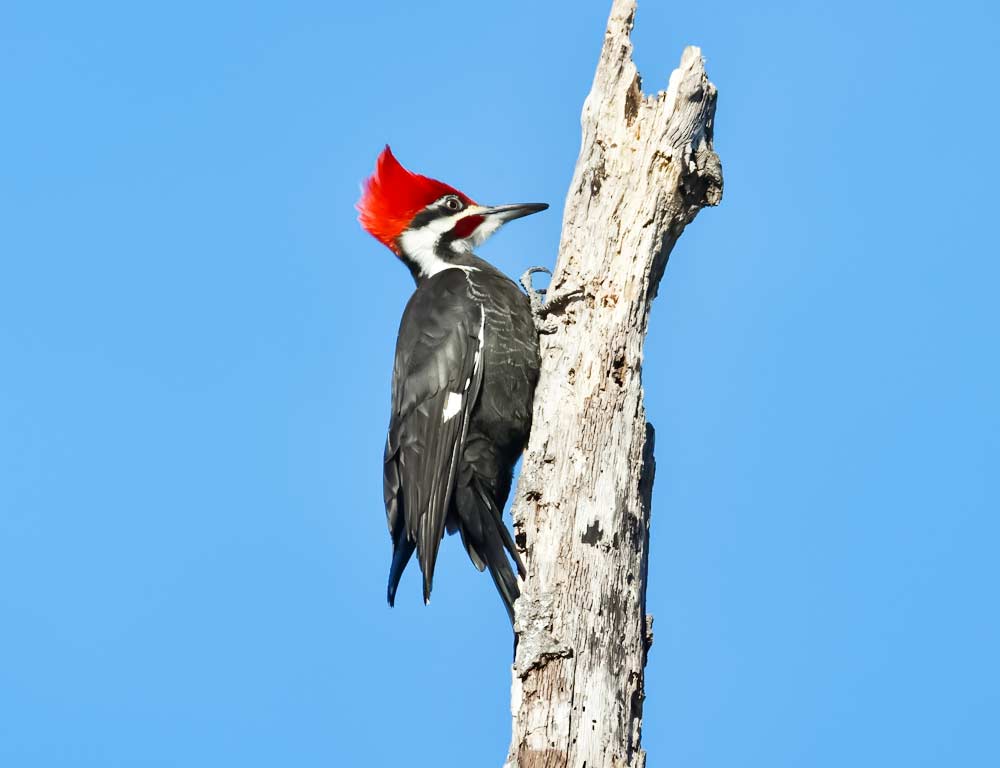
- Scientific name: Dryocopus pileatus
- Category: Woodpecker
- Population: Stable
- Food: Insects, fruits, and occasionally small vertebrates
- Life span: 7-10 years
- Size: 16-19 inches
- Weight: 8-12 ounces
The Pileated Woodpecker, a charismatic bird of the Oregon woodlands, is recognized by its striking black and white plumage and distinctive red crest.
Known for its loud drumming on trees and powerful excavation skills, the Pileated Woodpecker is a primary cavity excavator, creating nesting sites in dead or weakened trees.
Its diet consists mainly of insects, such as carpenter ants and wood-boring beetle larvae, but it also feeds on fruits and small vertebrates. This Woodpecker has adapted well to forested areas and can be found in mature coniferous and mixed forests.
2. Downy Woodpecker
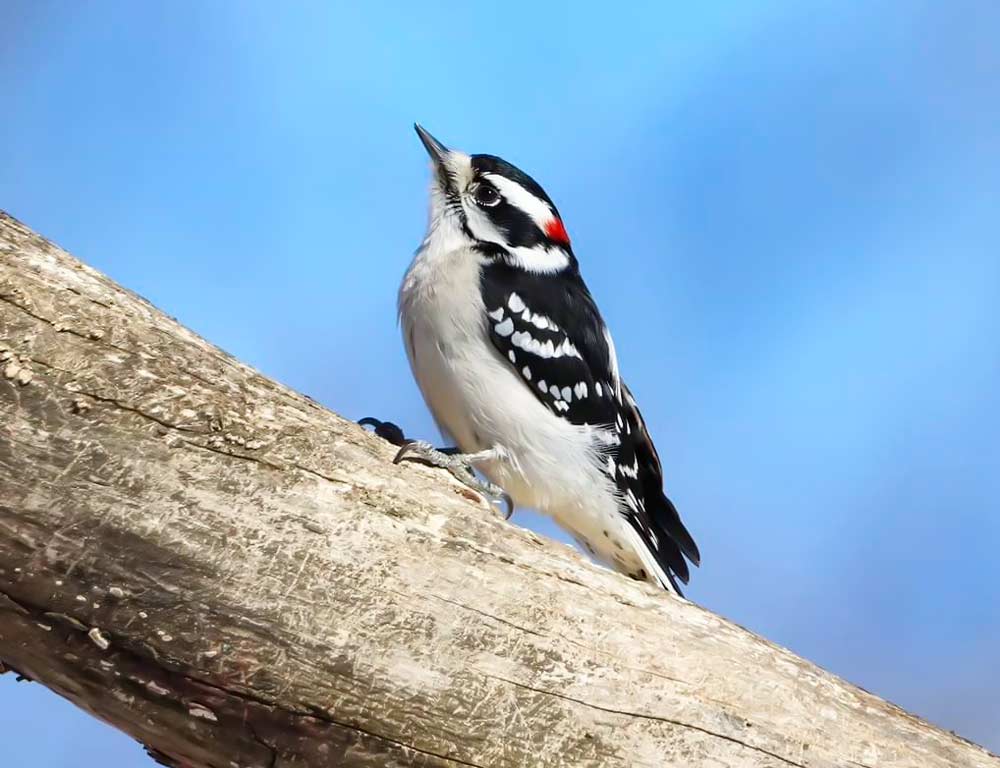
- Scientific name: Picoides pubescens
- Category: Woodpecker
- Population: Common
- Food: Insects, seeds, berries
- Life span: 4-6 years
- Size: 6-7 inches
- Weight: 1-1.5 ounces
The Downy Woodpecker is the most diminutive in Oregon, characterized by its black and white plumage, ladder-backed appearance, and a small red patch on the back of its head.
This adaptable bird is commonly found in various habitats, including parks and gardens.
Its diet primarily consists of insects, but it also feeds on seeds and berries. The Downy Woodpecker is a skilled forager, using its specialized bill to extract insects from tree bark.
3. Sapsucker
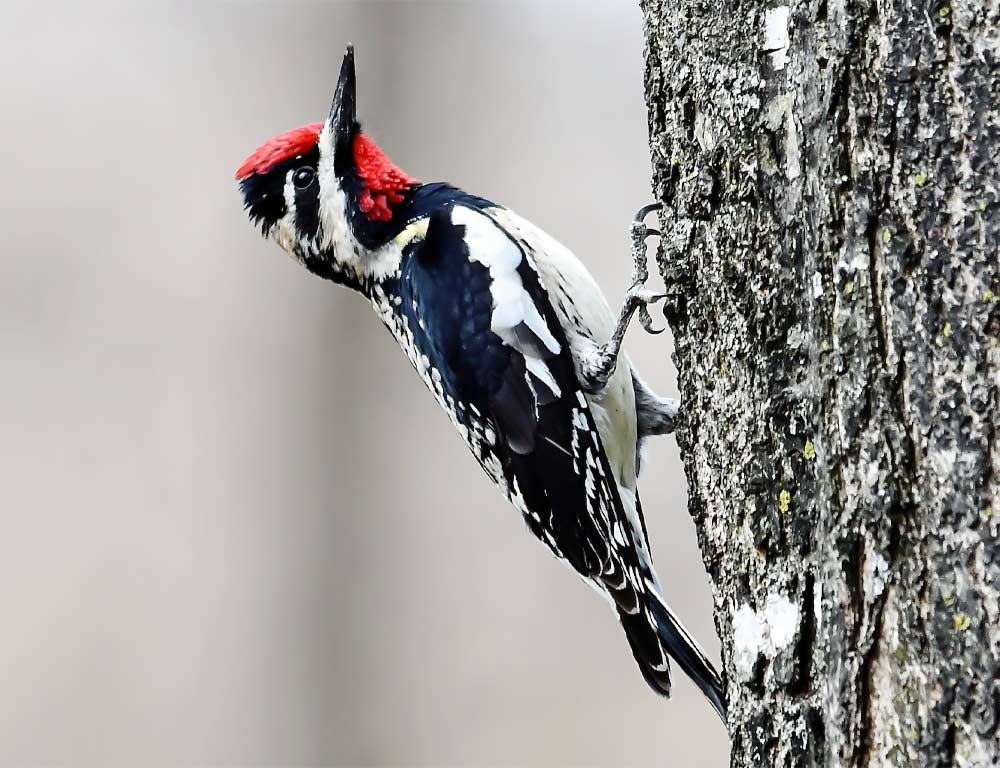
- Scientific name: Sphyrapicus spp.
- Category: Woodpecker
- Population: Variable
- Food: Tree sap, insects
- Life span: 4-8 years
- Size: 7-10 inches
- Weight: 1.5-3 ounces
The Sapsucker, a group of woodpeckers, including the Red-naped and Yellow-bellied Sapsuckers, is known for its unique feeding behavior.
These birds drill small holes in tree bark, creating sap wells to feed on the sugary sap, and the insects are attracted to it. They are often found in both coniferous and deciduous forests.
Sapsuckers play a role in ecosystem dynamics by benefiting other bird species and mammals utilizing sap wells. In addition to sap, they feed on insects caught in their sticky traps, contributing to their diverse diet.
4. Acorn Woodpecker
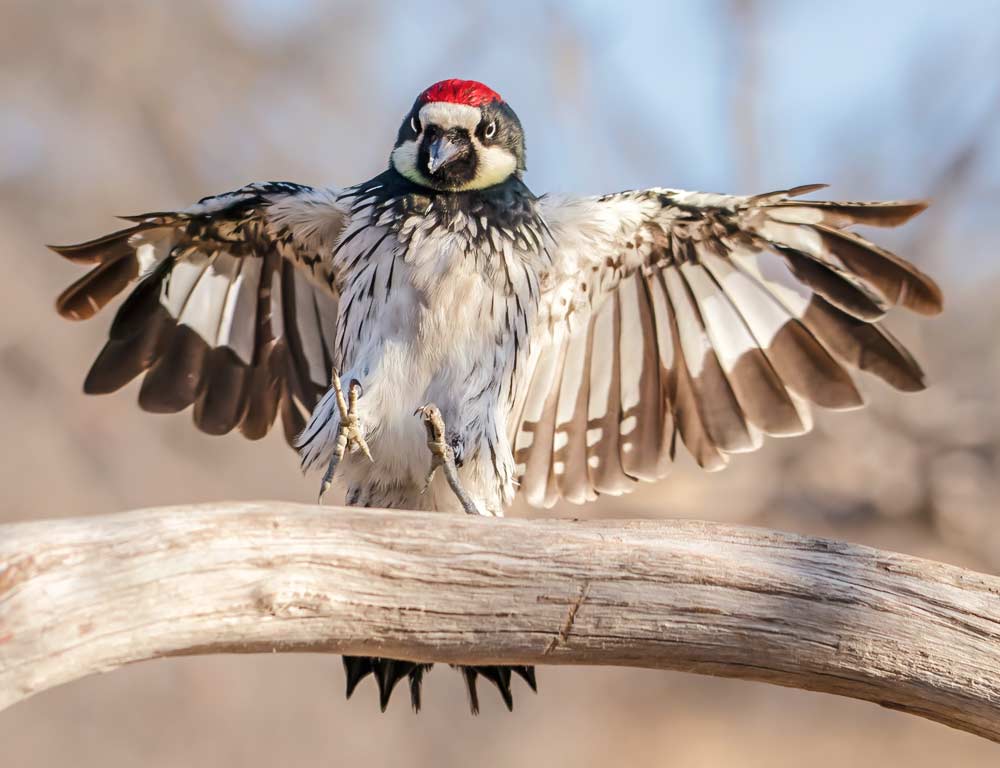
- Scientific name: Melanerpes formicivorus
- Category: Woodpecker
- Population: Stable
- Food: Acorns, insects, fruits
- Life span: 9-15 years
- Size: 9-10 inches
- Weight: 5-6 ounces
The Acorn Woodpecker is a social and cooperative species found in Oregon’s oak woodlands. Recognizable by its striking black and white plumage, the Acorn Woodpecker is mainly known for its unique storage behavior.
It drills holes into trees, utility poles, and other wooden surfaces to store acorns, creating communal granaries. These granaries serve as a reliable food source during winter months. Besides acorns, they also feed on insects and fruits.
Living in family groups, Acorn Woodpeckers exhibit complex social structures, with individuals participating in cooperative breeding and granary defense.
5. Northern Flicker
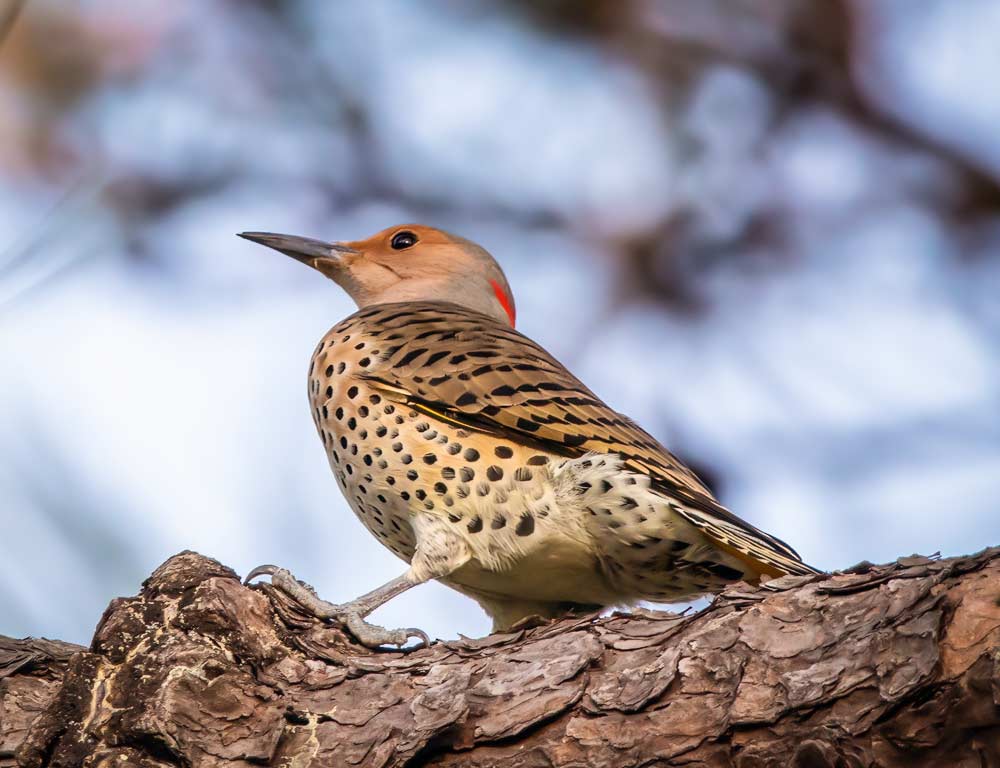
- Scientific name: Colaptes auratus
- Category: Woodpecker
- Population: Common
- Food: Insects, ants, fruits
- Life span: 6-8 years
- Size: 11-14 inches
- Weight: 3-5 ounces
The Northern Flicker is a versatile woodpecker species found across various habitats, including forests, open woodlands, and urban areas.
Identified by its distinctive spotted plumage and unique undulating flight pattern, these woodpeckers are skilled foragers.
They use their slightly curved bill to extract insects from the ground and trees. Northern Flickers have a diverse diet that includes ants, beetles, fruits, and seeds.
They are ground foragers and can often be seen feeding on the ground, using their long tongues to capture prey. Northern Flickers also engage in drumming behavior on resonant surfaces to communicate with each other and establish territory.
6. Black-backed Woodpecker
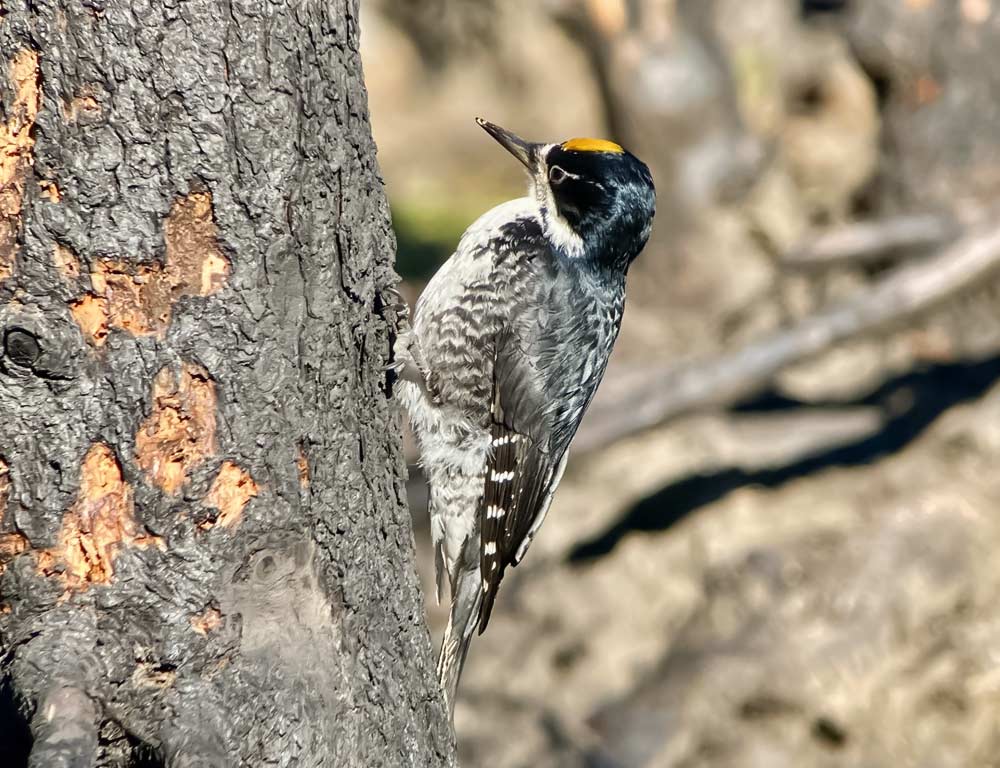
- Scientific name: Picoides arcticus
- Category: Woodpecker
- Population: Variable
- Food: Insects, especially wood-boring beetles
- Life span: 4-8 years
- Size: 9-10 inches
- Weight: 2-4 ounces
The Black-backed Woodpecker is well-adapted to boreal and subalpine forests, including areas with recent burn scars.
Identified by its black back and white underparts, this Woodpecker specializes in foraging for insects, particularly wood-boring beetles, in dead or dying trees.
They play a crucial ecological role by helping control insect populations and contributing to forest regeneration after wildfires.
Black-backed Woodpeckers are known for their preference for burned forests, where they find an abundance of beetle larvae in charred trees.
Their elusive nature and habitat preferences make them a unique and fascinating species for birdwatchers and researchers.
7. Lewis’s Woodpecker

- Scientific name: Melanerpes lewis
- Category: Woodpecker
- Population: Declining
- Food: Insects, fruits, nuts
- Life span: 6-10 years
- Size: 10-11 inches
- Weight: 4-7 ounces
Lewis’s Woodpecker is a distinctive species characterized by its unique plumage, pink-red belly, greenish-black upperparts, and dark face.
Found in open ponderosa pine forests and other woodlands, this Woodpecker is known for its aerial foraging habits.
Unlike other woodpeckers, Lewis’s Woodpecker catches insects on the wing, resembling a flycatcher more than a typical woodpecker. In addition to insects, they feed on fruits and nuts.
These woodpeckers are cavity nesters, often utilizing abandoned woodpecker holes or natural tree hollows for nesting. Threats to their habitat, such as logging and habitat fragmentation, contribute to their declining population.
8. White-headed Woodpecker
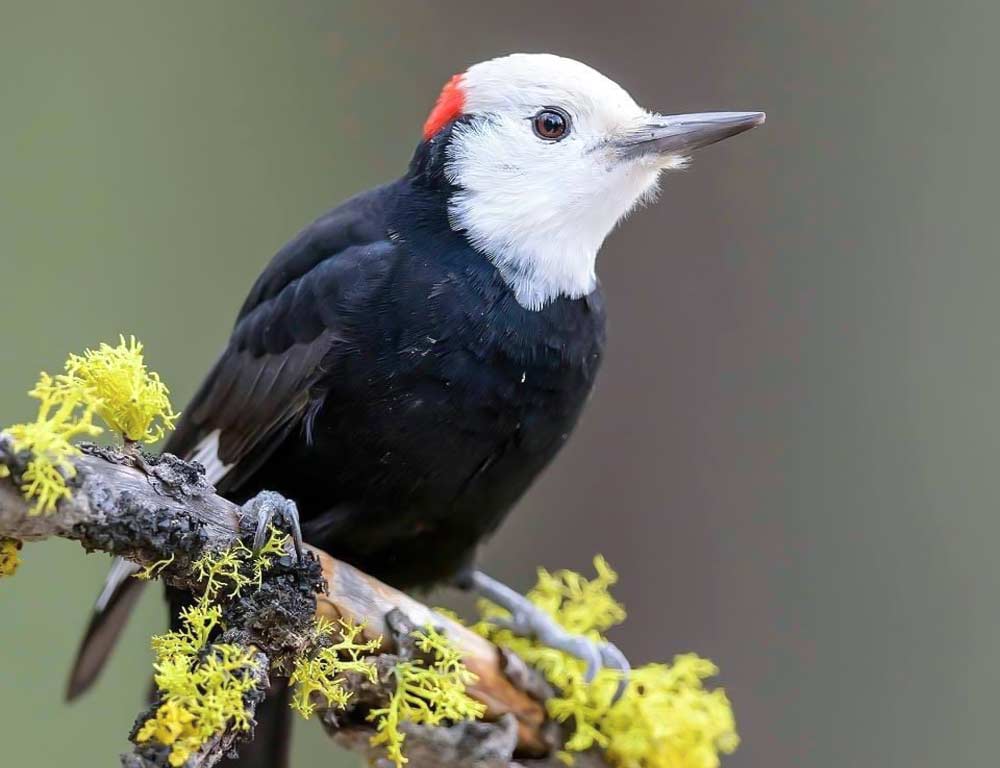
- Scientific name: Dryobates albolarvatus
- Category: Woodpecker
- Population: Stable
- Food: Insects, seeds
- Life span: 6-10 years
- Size: 8-9 inches
- Weight: 2-4 ounces
The White-headed Woodpecker is a high-mountain species that inhabits coniferous forests, particularly pine-dominated landscapes. As the name suggests, these woodpeckers have striking white heads and black bodies.
They have a specialized diet that includes insects, especially wood-boring beetles and seeds. White-headed Woodpeckers are known for their ability to extract seeds from pine cones using their substantial bills.
Their foraging behavior plays a role in shaping forest ecosystems by influencing the composition of tree species. They are cavity-nesting birds, often selecting dead or dying trees for nesting sites.
9. Williamson’s Sapsucker
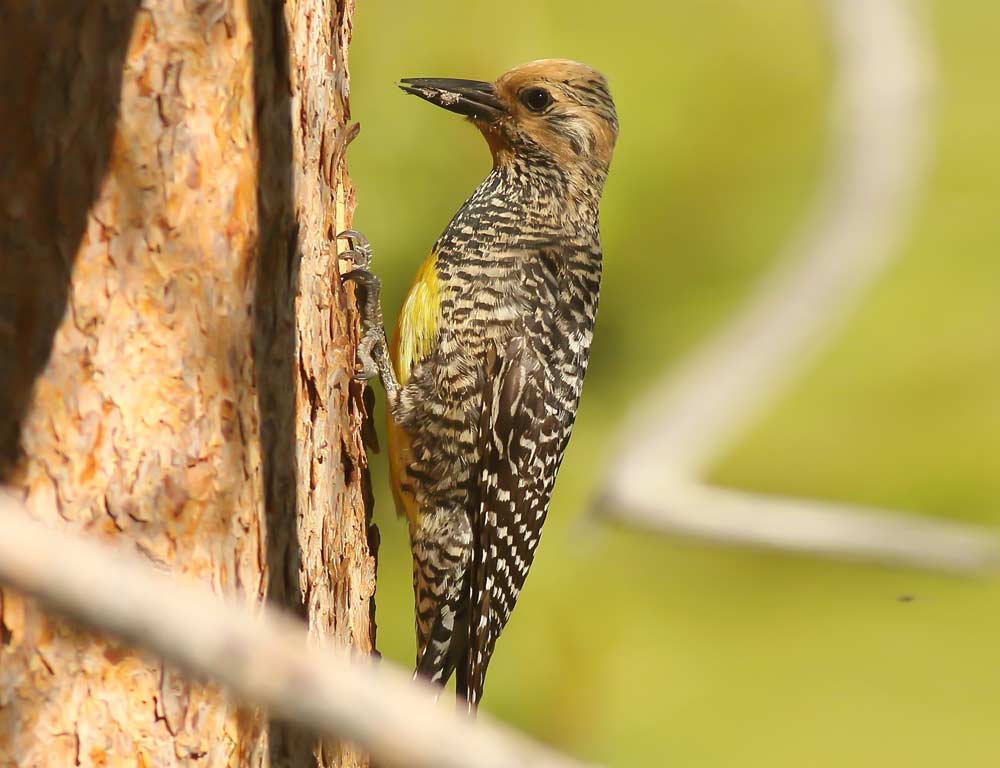
- Scientific name: Sphyrapicus thyroideus
- Category: Woodpecker
- Population: Variable
- Food: Tree sap, insects
- Life span: 5-10 years
- Size: 8-9 inches
- Weight: 2-4 ounces
Williamson’s Sapsucker is a medium-sized woodpecker with distinctive black and white plumage, a red throat patch on males, and yellow wing linings.
This species is typically found in coniferous forests, particularly those with mature and old-growth trees. As a sapsucker, it drills tiny holes in tree bark to feed on sap, insects, and cambium.
Unlike other sapsuckers, Williamson’s Sapsucker often selects a single, well-used tree for sap-feeding, creating characteristic horizontal rows of sap wells.
They also catch insects attracted to the sap. This species plays a unique role in forest ecosystems, creating habitat for other wildlife that utilize sap wells.
10. Red-naped Sapsucker
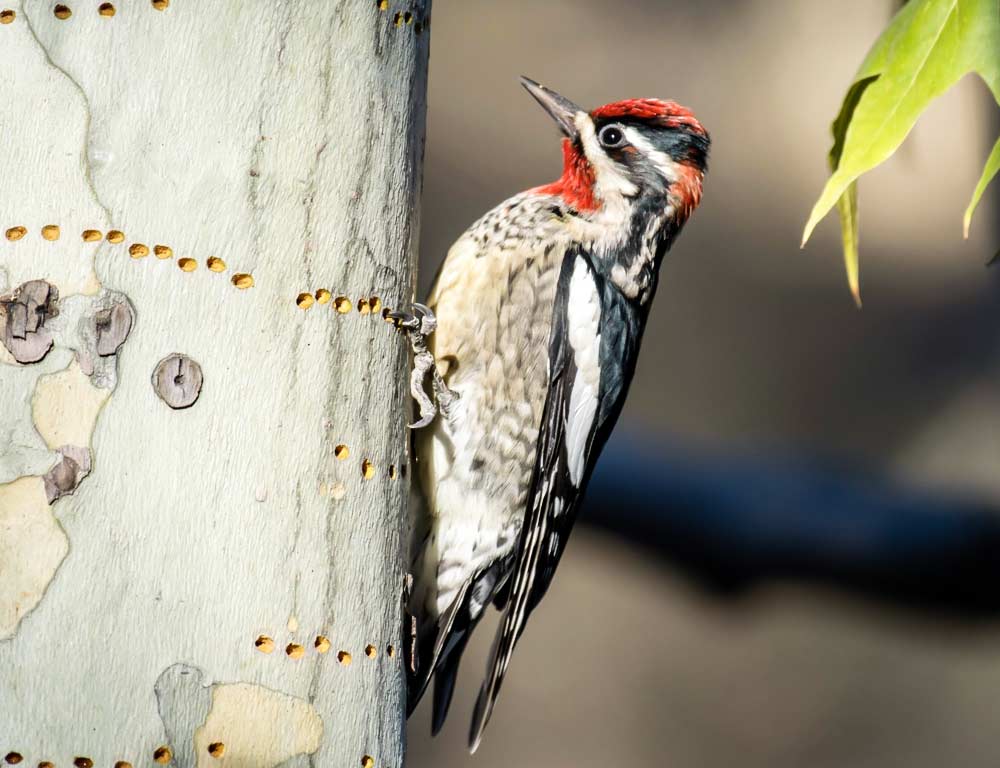
- Scientific name: Sphyrapicus nuchalis
- Category: Woodpecker
- Population: Stable
- Food: Tree sap, insects
- Life span: 5-8 years
- Size: 7-8 inches
- Weight: 1.5-3 ounces
The Red-naped Sapsucker is a medium-sized woodpecker characterized by its black and white plumage, a red throat patch on males, and a distinctive red patch on the nape of its neck.
Found in coniferous and mixed woodlands, these sapsuckers are known for their feeding behavior. They drill small holes in tree bark to feed on sap and insects, creating sap wells.
Red-naped sapsuckers create habitats for other wildlife that benefit from the sap wells, including hummingbirds and birds. They are often found in mountainous regions with a mix of coniferous and deciduous trees.
11. Red-breasted Sapsucker
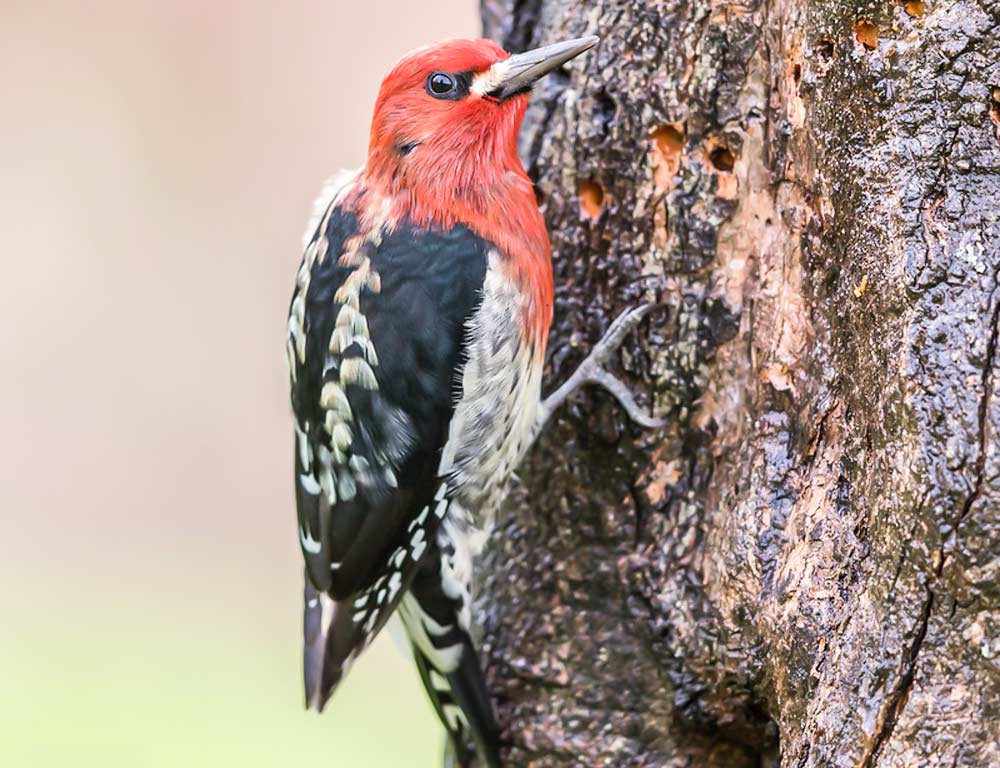
- Scientific name: Sphyrapicus ruber
- Category: Woodpecker
- Population: Stable
- Food: Tree sap, insects
- Life span: 4-8 years
- Size: 8-10 inches
- Weight: 2-4 ounces
The Red-breasted Sapsucker is a colorful woodpecker species with a striking red head and throat.
Found in the western parts of North America, including Oregon, these sapsuckers inhabit coniferous and mixed forests. Like other sapsuckers, they feed on tree sap and insects by drilling small holes in tree bark.
Their feeding activity creates a distinct pattern on trees with rows of sap wells. Red-breasted Sapsuckers also play a role in attracting other bird species to their sap wells, contributing to the biodiversity of their habitats.
12. American Three-toed Woodpecker
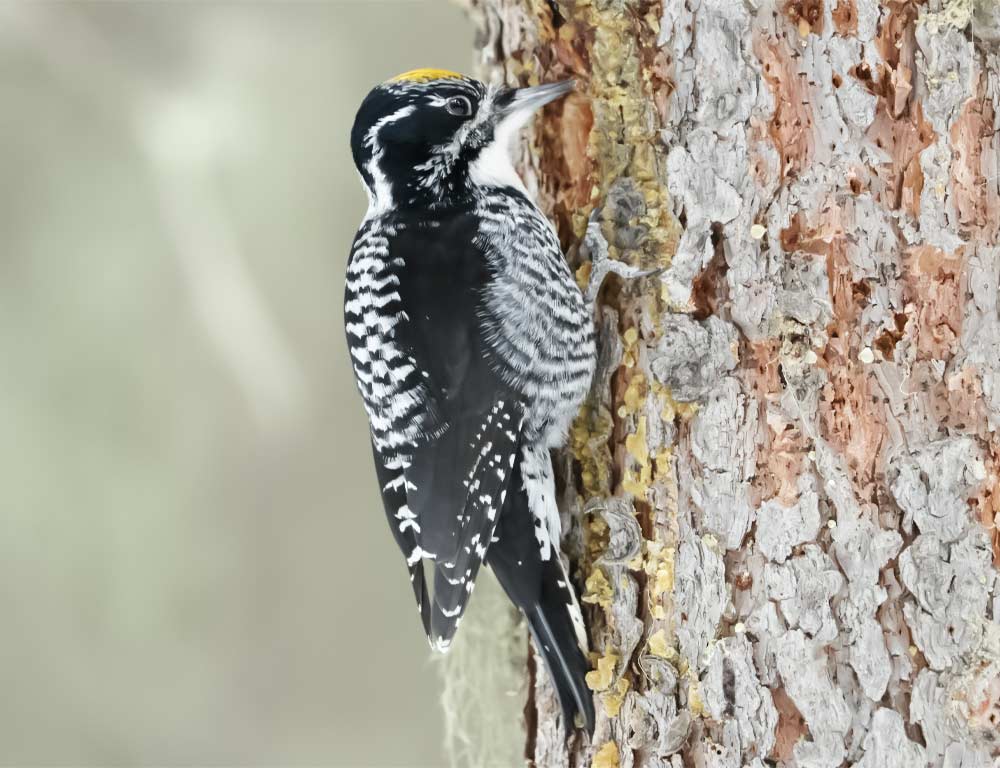
- Scientific name: Picoides dorsalis
- Category: Woodpecker
- Population: Stable
- Food: Insects, especially wood-boring beetles
- Life span: 4-8 years
- Size: 8-9 inches
- Weight: 2-4 ounces
The American Three-toed Woodpecker is adapted to coniferous forests, including subalpine and boreal habitats. This Woodpecker is recognized by having three toes instead of the typical four in other woodpeckers.
American Three-toed Woodpeckers are skilled foragers who extract wood-boring beetles under tree bark.
They are crucial in controlling insect populations, especially in areas affected by wildfires or insect outbreaks. These woodpeckers are known for their preference for dead or dying trees, where they can easily access their insect prey.
13. Nuttall’s Woodpecker
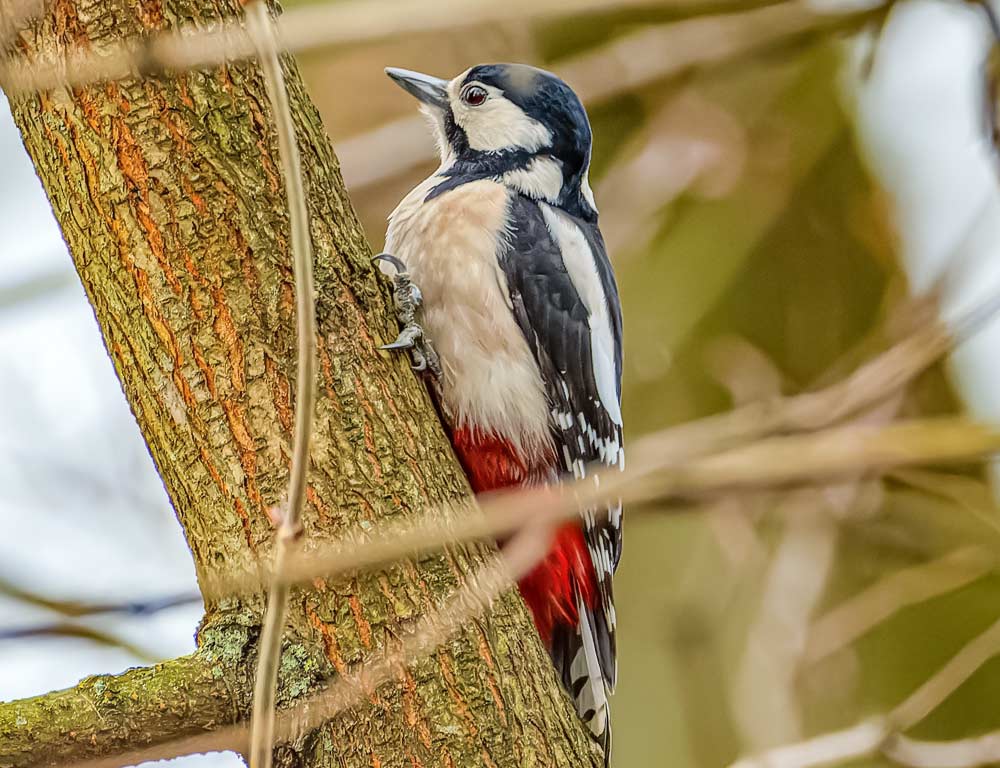
- Scientific name: Dryobates nuttallii
- Category: Woodpecker
- Population: Stable
- Food: Insects, spiders, seeds
- Life span: 4-8 years
- Size: 7-8 inches
- Weight: 1.5-3 ounces
Nuttall’s Woodpecker is a small, black-and-white species commonly found in oak woodlands and riparian areas. They have a distinct barred pattern on their back and a red crown on their head.
These woodpeckers feed on insects and spiders, foraging on tree trunks and branches. Nuttall’s Woodpeckers also consume seeds, nuts, and berries, providing a diverse diet.
They are cavity-nesting birds, often selecting trees with softer wood for excavation. Their adaptability to various habitats makes them a common sight in wooded areas of Oregon.
Wrapping Up
Oregon’s woodpeckers add vibrancy to its ecosystems, showcasing nature’s intricate balance.
From the Acorn Woodpecker’s communal habits to the specialized foraging of the American Three-toed Woodpecker, these birds enrich our understanding of local biodiversity.
Understanding and appreciating their roles in maintaining healthy forests is crucial for conservation efforts.
As stewards of these habitats, we must continue to safeguard the environments that sustain these charismatic woodpeckers, ensuring the continuation of their unique behaviors and contributions to the ecosystem. I appreciate your support.